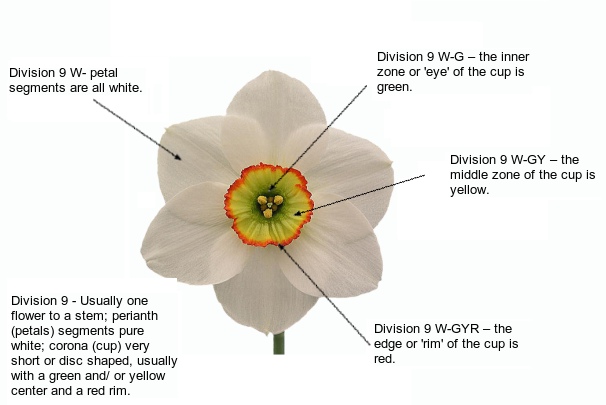The American Daffodil Society describes daffodils using three characteristics: “Division”, “Perianth Colors (petals)” and “Corona Colors (cup)” and this is a system of daffodil classification. These number and letter combinations are the standard way of describing and classifying daffodils and are the same as you would see in many daffodil catalogs. The daffodil color coding system was devised by Dr. Tom Throckmorton of Iowa, United States. In 1975, the Royal Horticultural Society (RHS) of the United Kingdom adopted Throckmorton’s color code system as part of their official system for daffodil classification. The American Daffodil Society follows the RHS daffodil classification system.
The Division and Color Codes of an individual daffodil is part of its official registration with the RHS. The classification of an individual daffodil is based on the hybridizer’s choices when he or she registers the daffodil. If the flower grows with a red cup in Australia where a hybridizer lives his or her flower will be registered with a red cup. However, it may grow differently in your region, for example with an orange cup. The Throckmorton classification system describes the colors of a daffodil from one to three zones for each perianth (petals) and corona (cup).
The following diagram is of “Patois”, a Division 9 W-GYR daffodil:
The classification of a daffodil cultivar (cultivated variety) is based on the description and measurements or the classification submitted by the person registering the variety. Details about how this classification system is applied are below:
- Color codes used to describe the color of daffodils are as follows:
- W – White or Whitish
- G -Green
- Y – Yellow
- P – Pink
- O – Orange
- R – Red
- For the purpose of the description, the daffodil is divided into two regions, the perianth (petals) and corona (cup).
- The perianth (petals) is described using letters of the color code most appropriate, identifying first the outside edge of the petal, then the middle, and lastly the inside part next to the corona.
- The corona (cup) is described using letters of the color code most appropriate, beginning with the inside, eye-zone, then the mid-zone and extending out to the edge or rim.
- The written format used to describe the classification of a daffodil is the following:
- division designation (number 1-13),
- letter or letters of the color code most accurately describing the zones of the perianth followed by a hyphen,
- letter of the color code, most accurately describing the zones of the corona
-
In Division 4, double daffodils, the letters of the color code accurately describing the mixture of petals and petaloids follow in proper order, using three, two, or one color codes as appropriate.
- If the perianth and/or corona are substantially of a single color; a single letter of the color code is used to describe its classification.Whether of wild or cultivated origin, once a selection has been distinguished by a cultivar name it is normally assigned to Divisions 1-12. Daffodils distinguished solely by botanical name should be assigned to Division 13.
Whether of wild or cultivated origin, once a selection has been distinguished by a cultivar name it is normally assigned to Divisions 1-12. Daffodils distinguished solely by botanical name should be assigned to Division 13.
Notes:
The characteristics for Divisions 5 to 10 are given for guidance only; they are not all necessarily expected to be present in every cultivar assigned to those divisions.
All daffodils are classified into one of the thirteen divisions. For photograph examples of each Division, see our web page Daffodil Divisions and Cultivars.
 Join us in Herndon, Virginia from April 10 – 13, 2024 for the ADS National Convention! Refer to the
Join us in Herndon, Virginia from April 10 – 13, 2024 for the ADS National Convention! Refer to the